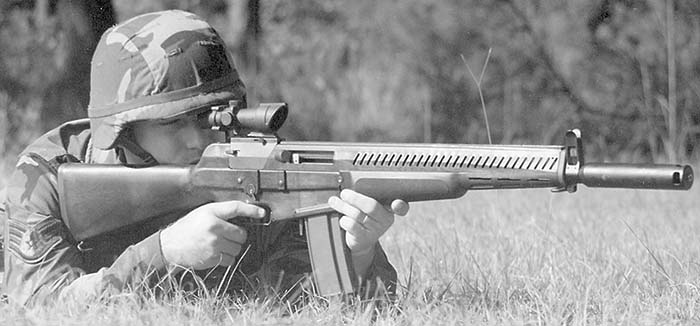The AAI ACR, a modified version of the previous AAI SBR rifle, as it appeared in the ACR field experiment. This rifle fired a 5.56x45mm subcaliber flechette round at 4,600 fps, at a cyclic rate of 1,800 rpm in the three-round burst mode. (U.S. Army)
By R. Blake Stevens
“Reorienting” the SPIW and Adopting the XM16E1
Again, as had been the case in 1964, the most charitable conclusion after the second generation SPIW trials was that neither of the “weapon concepts” was acceptable in its present state. The AAI SPIW was chosen as the better of the two: hardly a choice at all in view of the enforced termination of the Springfield program and the lack of any immediate civilian interest in its continuance.
Early in the fittingly gray month of November, 1966, the Infantry Board formally recommended to the Chief of Staff of the Army that the whole SPIW program be radically pruned back and relegated to the status of an exploratory program at AAI.
On November 7, the Office of the Chief of Staff accordingly directed that the SPIW program be “reoriented” from full-scale engineering development back to exploratory development, becoming in the process just one facet of a broadened, long-term small arms R&D program for the future. The same memorandum announced the formal intention to adopt the Colt XM16E1 rifle as standard for the U.S. Army everywhere but in the European theater.
With the Army having thus come full circle and now solidly behind the M16, the pressing need for the SPIW simply vanished. For the SPIW itself, the collapse of the second generation program marked the end of the lavishly-funded grande époque, the likes of which would never be seen again.
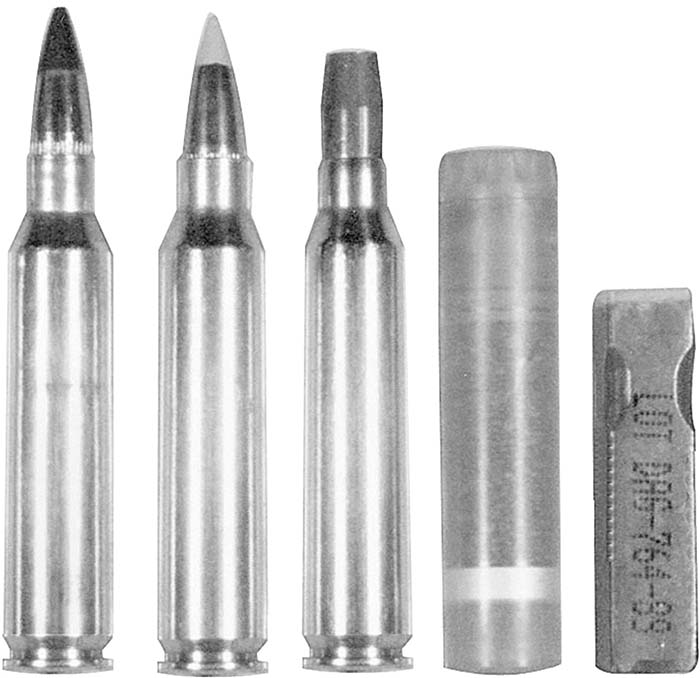
The AAI XM19 Serial Flechette Rifle (SFR)
Nevertheless, development continued at AAI over the next few years, funded largely from within the company. This led to a heady but temporary resurgence of interest in the flechette-firing SPIW.
The Army had seized on the limited but encouraging success of AAI’s 1967 nominal-fee contract modifications, authorizing an additional $500,000 in fiscal 1968 to step up produceability studies on flechette ammunition.
The Army’s new four-phase serial flechette rifle (SFR) contract with AAI became a reality in October, 1968. A field experiment had already been tentatively scheduled for April, 1970, wherein the new SPIW would be compared with the M16A1 under simulated combat conditions.
HQ Army Weapons Command (now called WECOM) publicly confirmed the awarding of the letter contract to AAI on January 21, 1969, “for continued development of the Special Purpose Individual Weapon (SPIW) and its associated ammunition.” A scant six months later in June, WECOM announced that the phase-two prototypes, now officially called the “XM19 Rifle, 5.6mm, Primer Activated, Flechette Firing,” were under construction. This first bestowal of an official “XM” number on a SPIW candidate was an important and long-awaited honor: it signified formal recognition that the SPIW had advanced one indispensable step closer to becoming the Army’s next rifle system.

Calling the SPIW to Account
If anything could have saved the SPIW program it was AAI’s improved XM19 rifle and its later, short-lived follow-on, the XM70, which fired from the open bolt. However, to an increasing number of observers, both in and outside the program, the curious and continued determination to ignore the fundamental gulf between the SFR (SPIW) requirements and the real world needed to be addressed. On July 30, 1969, Congressman Richard L. Ottinger of the House of Representatives wrote a formal letter to the Comptroller General of the United States. By this time, some aspects of the Future Rifle Program were already under investigation by the U.S. General Accounting Office (GAO). An excerpt from Mr. Ottinger’s letter reads as follows:
… I am writing in regard to the Special Purpose Individual Weapon (SPIW) currently being developed by the AAI Corporation for the Department of the Army… It is my understanding that after seven years of research and development and the expenditure of some $20 million, the SPIW is still not ready for production and use. I further understand that some five different engineering deficiencies have been identified and that it is anticipated that some additional 12 to 18 months will be necessary to correct these deficiencies.
I would appreciate your advising me as to how much more it will cost to correct the five present deficiencies and whether any additional research and development funds will be spent; why is this weapon being developed in the first place, [and] when will the SPIW be ready for use by our Armed Forces personnel?
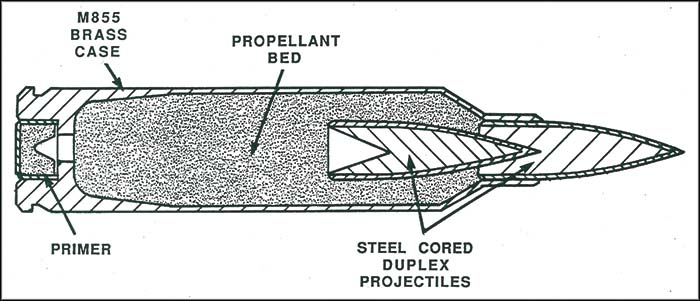
The XM19 is Snatched from Near Perfection
Ironically, it appears that by this time the AAI weapon was virtually at the point of perfection, and yet as the XM19 neared this tantalizing goal its detractors gained in voice and power, and the mood of good fortune, which had begun in 1967, began to slip away, never to return.
Withdrawal from Vietnam Pulls the Plug on the SPIW
In the midst of all these acrimonious thrusts and investigations, the 1973 end of the American military presence in Vietnam effectively “pulled the plug” on any urgent, large-scale development plan for a new U.S. individual weapon. Small arms research, development and engineering (RD&E) money dried up abruptly, adding an indisputable air of finality to the last SPIW developments. As stated in the Research, Development and Engineering (RD&E) Laboratory Posture Report for fiscal 1974, prepared by Army Armament Command at Rock Island:
… In December 1973, the decision was made to remove flechette ammunition from immediate consideration within the FRS (Future Rifle Systems) Program because of technical problems which may not be correctable in the time frame of the future rifle…
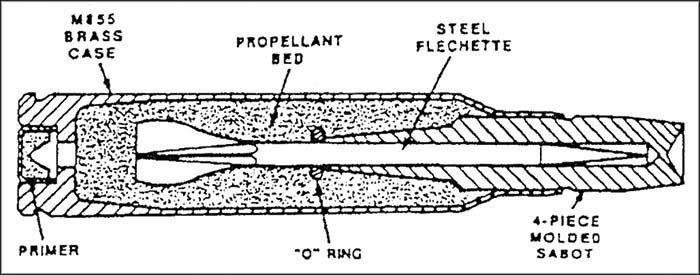
Summing Up the Failed SPIW Program
The point target portion of the AAI SPIW was designed to fire controlled bursts of 10-grain flechettes at 2,400 rpm, thus taking advantage of the flechette’s minimal recoil to achieve a deadly, ultra-tight mean burst spread. As regards the crucial characteristic of recoil impulse, the 10-grain flechette still reigns supreme, far superior to the M16 on full-automatic fire. As recorded in The Black Rifle, a comparison prepared by the Human Engineering Labs (HEL) at Frankford Arsenal showing the typical recoil impulse of several standard weapons reads as follows:
7.62mm NATO M14: 2.65 lb. sec.
.30 M2 Carbine: 1.18 lb. sec.
5.56mm M16 (w/muzzle brake): 1.16 lb. sec.
AAI SPIW (no muzzle brake): 0.65 lb. sec.
AAI SPIW (w/muzzle brake): 0.39 lb. sec.
For such a light projectile to be lethal, however, a muzzle velocity in the order of 4,800 fps was required. This in turn necessitated a chamber pressure approaching 70,000 psi.
In the frantic attempt to perfect weapons capable of attaining these pressures and velocities, many frontiers of knowledge had to be pushed back, all at the same time. This in turn uncovered a veritable host of new technological problems that could not possibly have been foreseen and which, ironically, were misconstrued as poor engineering. It was the previously unheard-of magnitude of these new problems – heat; erosion; muzzle blast; component overstressing and flechette cartridge complexity – which ultimately proved insurmountable within the overall timing and funding constraints set for the program.

A Brief Reprieve – in the ACR Program
The following is excerpted from the Collector Grade title Black Rifle II, written by Christopher R. Bartocci and published in 2004 as a follow-on to The Black Rifle, which had covered the early history of the M16 up to the time of its publication in 1987.
We begin with an overview of, and rationale for, the Advanced Combat Rifle (ACR) program from Black Rifle II, as follows:
Throughout the last half of the twentieth century, the U.S. Department of Defense initiated several programs aimed at replacing the M16 series rifles altogether with a new design.
When the AR-15/M16 was first adopted during the early 1960s, it was considered merely an interim weapon while development of the futuristic, flechette- and grenade-firing Special Purpose Individual Weapon (SPIW) was under way. At that time it was confidently predicted that the SPIW would be classified “Standard A” by June of 1965. Despite a great deal of costly effort, however, the SPIW concept was never perfected.
Twenty years later, during the period 1986 to 1990, the Department of the Army tried again, by funding the Advanced Combat Rifle (ACR) program.
It had been a hard but valuable lesson to learn that, due to the high levels of stress, fatigue and fear experienced during actual combat engagements, soldiers will not shoot as well as they were trained to shoot. The objective of the ACR program was to replace the M16A1, and the then newly-adopted M16A2, with a new rifle, which would increase both hit probability and combat effectiveness by 100%.
Excerpts from a voluminous retrospective prepared by the Army Research, Development and Engineering Center (ARDEC) at Picatinny Arsenal titled ACR Program Summary read as follows:
“The ACR Operational and Organizational Plan (O&O) was approved in January, 1985 [which] caused weapon concepts to be developed under contract and prototype hardware to be produced and evaluated with troops in a field experiment.
“In September 1982 contracts were awarded to AAI Corporation and Heckler & Koch, Inc.
“In 1984 – 1985, industry conferences were held at ARDEC and Fort Benning. Shortly thereafter, contracts were competitively awarded to AAI, ARES, Colt, McDonnell Douglas, and Steyr [calling] for the development and fabrication of the proposed rifle systems for evaluation in government tests. Both the ARES and McDonnell Douglas contracts were terminated before the final ACR field experiment took place, due to “lack of maturity” of their systems.”
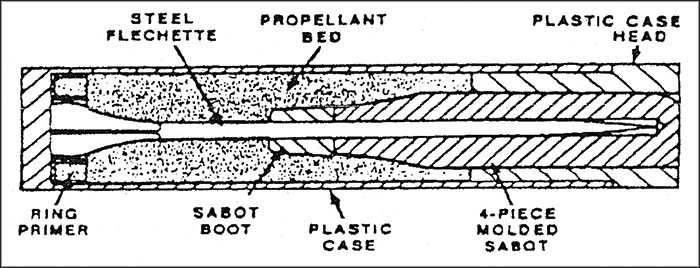
The AAI ACR
“AAI was the repository of the equipment necessary to produce the flechettes needed for both their contract and the Steyr-Mannlicher contract. The production of flechettes was a cost, time and quality problem throughout the entire development effort. There is some controversy as to whether the flechette round is inherently less accurate and whether any amount of future development effort would result in equal accuracy to a standard bulleted round. The pace of technology today is such that it is unlikely that further development work on small-caliber flechettes will be funded for rifles.
“The AAI weapon is a 5.56mm modified version of the previously developed Serial Bullet Rifle (SBR) using a reciprocating bolt mechanism.
“The AAI round uses the standard 5.56mm M855 brass case with M41 primer. The projectile is a 10.2 grain sub-caliber flechette. The sabot is a liquid crystal polymeric compound (plastic), which is designed in four segments held together by a neoprene “O” ring at the rearmost point of the sabot segments.”
The Steyr ACR
“The Steyr system was similar to the ARES system in that it fired using a rising chamber mechanism. However the Steyr ACR fired a single flechette from a plastic case using a radial ring primer. Initiation of the ring primer was from the side of the case near the base.
“The Steyr gun is a true open-bolt mechanism in that there is a spent case normally in the chamber in the out-of-battery condition. A live round only enters the chamber after the trigger has been pulled.
An inherent drawback to the Steyr system lies in sabot hazard to friendly troops. This is a safety concern that exists in the AAI system as well.
The Colt ACR
The Colt ACR was essentially a product-improved M16A2, painstakingly modified to meet the criteria of increased hit probability and combat effectiveness. It was fitted with a new hydraulic buffer, a modified pistol grip, a flat-top receiver with an integrated rail, capable of accepting a detachable carrying handle embodying the A2-style adjustable rear iron sight or the ELCAN (Ernst Leitz, Canada) optical sight, plus a heightened sighting rib proposed by the Army HEL (Human Engineering Laboratory) mounted on a semi-beavertail handguard, and a proprietary muzzle brake/compensator designed by Knight’s Armament Co.
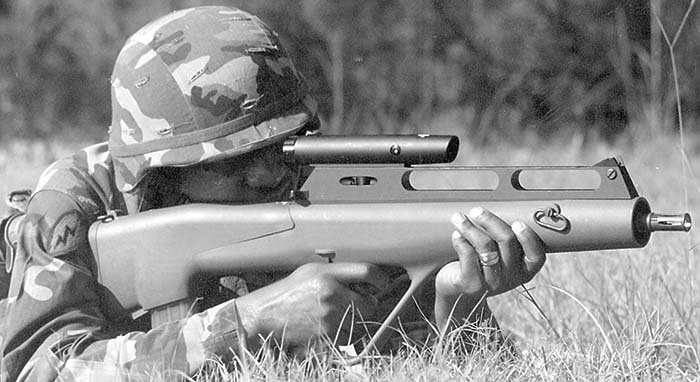
Conclusions of the ACR Program -Reaffirming the M16A2
None of the ACR contenders emerged as a replacement for the existing arsenal of conventional rifles. However, the unprecedentedly sophisticated data collection systems developed for the program, which included the ability to not only record hits but to actually measure the amount by which a shot missed the target as well, led to some highly encouraging conclusions regarding the ACR contenders, plus an upwardly revised opinion of both the M16A2 and the soldiers who participated in the program. The following is a further excerpt from the ACR Program Summary:
… The baseline performance of the M16A2 rifle was better than anticipated in terms of hit probability… No rifles showed a n increase in probability of hit over the M16A2 under the stressed conditions of the test.
The feasibility of caseless and lightweight plastic-cased ammunition has more than been demonstrated in this program. Few problems were experienced with the [H&K] caseless rifles in the test. The past technical barriers of cook-off and vulnerability have now been overcome…
The End of the Road (So Far) for the Serial Flechette
A final excerpt from the ARDEC ACR Program Summary reads as follows:
… Many advances in high-performance rifle flechette technology have been made during this effort. New engineering plastics and sabot designs have solved previous launch reliability problems.
Although significant advances were made in reducing flechette round-to-round dispersion, the dispersion of flechettes is still greater than that of bullets. It is unlikely that the round-to-round dispersion will be reduced further, which would likely preclude flechettes from further consideration as single shot rifle projectiles.
[However,] their high cross-sectional energy density and large length-to-diameter ratio make them very effective against all small arms targets. This, together with their flat trajectory and short time of flight, make them attractive for consideration in crew-served and area-fire applications…
| This article first appeared in Small Arms Review V19N3 (April 2015) |



